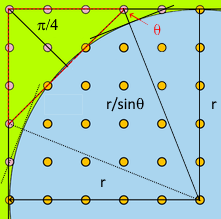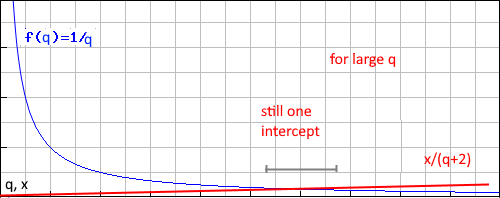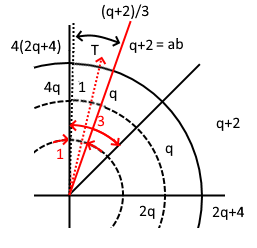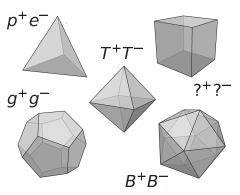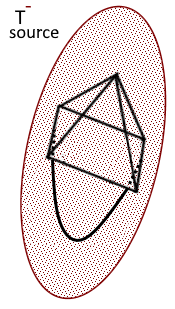Consider two primes, \(P1\) and \(P2\), we construct a quadrant with an arc ABC and another arc EFG. These arcs are of length.
arc ABC\(=P1+P2\) and
arc EFG\(=P1+P2+2\)
Both arcs are divided by its length to give integer points and provide markings, each of unit length \(1\),
Since there is symmetry about the bisector of the arcs, only one portion is discuss here. Since, \(P1+P2\) is even, this portion is always odd.
Let \(m+n=P1+P2\)
and
\(j+k=P3+P4=P1+P2+2\)
Consider,
\(\cfrac{P2}{P1+P2}=\cfrac{P3}{P1+P2+2}\)
\(P3=\cfrac{P1+P2+2}{P1+P2}P2=\cfrac{n}{n+m}(P1+P2+2)\)
\(\cfrac{k}{j+k}=\cfrac{P3}{(P1+P2+2)}=\cfrac{n}{n+m}\)
So,
\(\cfrac{1}{j+k}=\left(\cfrac{n}{k}\right)\cfrac{1}{n+m}\)
since \(n\lt k\)
the unit division along \((j+k)\) is a fraction of the unit division along \((n+m)\). \(P1\) is not a factor of \(P4\) and \(P2\) is not a factor of \(P3\).
In fact, given that the length of arc EFG is just one plus the length of arc ABC. This gain in a unit division is spread over the length of EFG There is no line through the origin that will meet both markings on ABC and EFG.
If a line OF is drawn from an integer mark on EFG, this line will not intersect with any integer mark on ABC. This is true for any marking on EFG, and so for all values of \(P4\). A missed integer marking means the obtained value is not an integer; it is not a valid value.
Also since, arc EFG has length,
arc EFG\(=P1+P2+2\)
and the lower arcs have length \(P1+P2\), \(P1+P2-2\)... ...\(6\),\(4\),\(2\)
There is a possible \(a\gt 1\), such that
\({P1+P2+2}=a\overset{ \frown}L\)
where \(\overset{ \frown}L\) is the length of a lower arcs.
\(\cfrac{1}{\overset{ \frown}L}=a.\cfrac{1}{P1+P2+2}\)
The unit markings on arc L is of multiple unit width on arc EFG.
A line OF through an integer point on this lower arc \(\overset{ \frown}L\) will cross another integer point along EFG. This would mean \(P4\) has a factor (like P1) on \(\overset{ \frown}L\), given by this intersection.
Consecutive marking on this lower arc L will intersect EFG at \(a\) spacing apart. That means there are \(a-2\) choices of \(P4\) for an \(a\) size aperture on EFG that do not have this factor.
\(a\) decreases with with longer arc length L. The choice of \(P4\) to avoid an integer marking on L also decreases. With a lower arc length of \(2\) that accommodates for the case \(P4=P3\), there are at most \((P1+P2-2)-2+1\),\(P1+P2-2\) (odd numbers discarded) possible values of \(a\) (every lower arc provides a factor and is avoided), excluded are \(L=(P1+P2)\) that provides no factors and \(L=1\). So, there is at least one choice on arc EFG that allows line OF to avoid all integer intersections on the lower arcs. (The one choice on arc of length \(P1+P2-2\) when all lower arcs have factors).
That means \(P4\) can have no factors. \(P4\) can be prime. The primes \(P1\) and \(P2\) guarantee that there is at least one choice of \(P4\) to be prime. The arc ABC allows line OF to sweep for all integer on EFG, to obtain a value for \(P4\) that is prime.
When \(P4\) is prime, and by symmetry \(P3\) is also prime (swap \(P3\) with \(P4\)). For \(P3\), start at the horizontal instead, line OF missing all markings on lower arcs. It is the same line when \(P4\) was discussed.
So, given two primes, \(P1\) and \(P2\) the sum of which is \(P1+P2\), there are then \(P3\) and \(P4\), such that the next integer,
\(P1+P2+2=P3+P4\)
and both \(P3\) and \(P4\) are prime.
So by induction, given that \((1+1=2)\), \((2+1=3)\), \((3,1=4)\) and \((3+2=5)\) all even numbers can be represented as the sum of two primes.
Goldbach's Conjecture is proven.
Note:
Factors found using this graphical method divide \(P3\), \(P4\) and their sum \(P3+P4=P1+P2+2\).
If OF crosses with integer markings on EFG and any of the lower arcs L, then a factor is found on L. That cannot happen. \(P1+P2+2\) cannot be divided. This derivation does not choose \(P4\) and \(P3\).
Starting from an integer marking on arc L, but the line OF misses integer markings on arc EFG, means \(P4\) and \(P3\) are not integers. Starting from an integer marking on EFG, but the line OF misses integer markings on L, means the lower arc does not provide a factor to both \(P4\) and \(P3\) and \(P1+P2+2\). Not just \(P4\). This graphical method find factors for \(P4\), \(P3\) and their sum \(P3+P4=P1+P2+2\).



